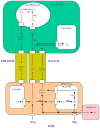Glutamine synthetase in legumes: recent advances in enzyme structure and functional genomics
- PMID: 22942686
- PMCID: PMC3430217
- DOI: 10.3390/ijms13077994
Glutamine synthetase in legumes: recent advances in enzyme structure and functional genomics
Abstract
Glutamine synthetase (GS) is the key enzyme involved in the assimilation of ammonia derived either from nitrate reduction, N(2) fixation, photorespiration or asparagine breakdown. A small gene family is encoding for different cytosolic (GS1) or plastidic (GS2) isoforms in legumes. We summarize here the recent advances carried out concerning the quaternary structure of GS, as well as the functional relationship existing between GS2 and processes such as nodulation, photorespiration and water stress, in this latter case by means of proline production. Functional genomic analysis using GS2-minus mutant reveals the key role of GS2 in the metabolic control of the plants and, more particularly, in carbon metabolism.
Keywords: Lotus japonicus; functional genomics; glutamine synthetase; nitrogen metabolism.
Figures




References
-
- Good A.G., Shrawat A.K., Muench D.G. Can less yield more? Is reducing nutrient input into the environment compatible with maintaining crop production? Trends Plant Sci. 2004;9:597–605. - PubMed
-
- Hirel B., Le Gouis J., Gallais A. The challenge of improving nitrogen use efficiency in crop plants: Towards a more central role for genetic variability and quantitative genetics within integrated approaches. J. Exp. Bot. 2007;58:2369–2387. - PubMed
-
- Keys A.J., Bird I.F., Cornelius M.J., Lea P.J., Wallsgrove R.M., Miflin B.J. The photorespiratory nitrogen cycle. Nature. 1978;275:741–743.
-
- Scott D.B., Farnden K.J.F., Robertson J.G. Ammonia assimilation in lupin nodules. Nature. 1976;263:703–705.
Publication types
MeSH terms
Substances
LinkOut - more resources
Full Text Sources

